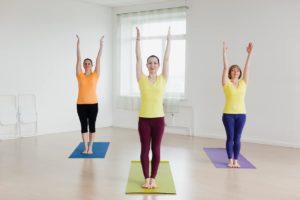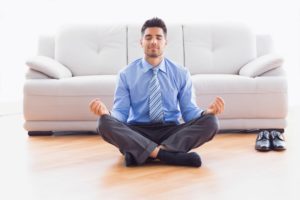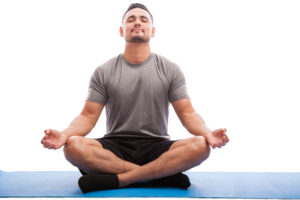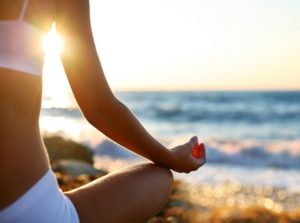The Science of Yoga
“Jane,” like many clients, tried yoga to reduce her stress and anxiety, but she often held her breath during triggering moments, taxing her to the point where she’d feel faint and need to lie on the floor. After taking yoga sessions with Nicole DeAvilla, RYT 500, of Kentfield, California, Jane immediately felt calmer, more grounded and more optimistic.
Are Yoga Postures Power Poses?
Next time you’re feeling down, you may want to try a yogic raised-hands pose, also known as the upward salute that is part of the sun salutation. You may recall research conducted by Amy J.C. Cuddy, PhD, MA, associate professor at Harvard Business School in Cambridge, Massachusetts, that suggested “power poses” can increase people’s sense of competence and power. Now, research suggests that open, expansive yoga postures held for 2 minutes may
increase self-esteem.
Control Your Moods, Achieve Your Goals
Anxious, fatigued, unhappy, uncertain? We’ve all been there, all known times when our emotional hot buttons take over. We swear to ourselves that this time we will overcome them and stay committed to our goal, but it doesn’t work and we react with indulgent self-gratification. “I had such a long day, and I just don’t feel like going to the gym today.” “I’ve already fallen off the wagon so I’ll just eat what I want and start again on Monday.”
Mindful or Mind Full?
It’s a busy, technology-dominated world—and most of us are continually spinning, twisting and turning in an effort to “get things done” and “produce.” We work, we raise families, we have countless responsibilities. The truth is, this is distracted living, and it raises stress levels, lowers productivity, interferes with our ability to focus and compromises the mind-body connection. When we live this way, we fail to cultivate a sense of contentment and joy, which is counterproductive to our work as fitness and wellness professionals.
Streamline Your Yoga Cuing
When you were new to teaching yoga, you had a lot to focus on. You navigated the room, demonstrated poses, gave hands-on adjustments, held space for emotions and skillfully managed time. In the early days, it may have felt like a victory just to make it through a class successfully!
Tai Chi: The Perfect Balance for Aging Adults
Why tai chi?
These Chinese movement patterns have been around for centuries. In recent years, study after study has proven the benefits of tai chi—particularly for older exercisers—yet most fitness professionals seem to know little about it.
That’s too bad, because just about any fitness client can learn tai chi, and any fitness professional can teach it. Like other types of exercise, tai chi simply requires you to learn its movements and experience its benefits.
U.S. Yoga Injuries Increasing
Yoga injuries in the United States are on the rise, particularly among older adults, according to data from hospital emergency rooms nationwide. Researchers from the Center for Injury Sciences at the University of Alabama in Birmingham (UAB), Alabama, examined data from 2001 to 2014 to establish the injury risk involved in yoga participation.
Mind-Body Exercise and Menopause
Are you in menopause? Chances are that you sometimes feel that you are not in control of your body! If you are seeking ways to cope with unpleasant menopausal symptoms, you may want to try yoga and other mind-body practices.
Shirley Archer, JD, MA, 2008 IDEA Fitness Instructor of the Year, an award-winning author and IDEA’s mind-body spokesperson, explains the research and application of mind-body exercise on menopause.
Irritability and Mood Swings
The Poetry of Yoga
Some 80 million Americans were expected to try yoga last year, according to the 2016 Yoga in America Study (Yoga Journal & Yoga Alliance 2016). Couple this statistic with the continuing effort to entice baby boomers with new and effective movement class designs, and you get a sense of the opportunity yoga provides for dedicated teachers with skill and creativity.
Treatment Guidelines for Chronic Lower-Back Pain
While some people with lower-back pain may doubt whether movement is the answer, new treatment guidelines from the American College of Physicians (ACP) recommend nondrug therapies as the first line of treatment to relieve acute, subacute and chronic lower-back pain.
Yoga and Prehypertension
Adding to the growing evidence of yoga’s health benefits, preliminary findings from a recent study show that consistent yoga practice may help to reduce blood pressure among people with prehypertension.
A Yoga-Based Finish
Sun salutations integrate strength, endurance, flexibility, controlled breathing and mindfulness. This cycle of postures is traditionally used in many yoga classes to warm up the body, as the sequence addresses all major joints and muscle groups while increasing blood flow and circulation. However, it also helps to release stress on the spine and promote relaxation, a perfect combination for a cool–down!
Yoga Guidelines for People With Glaucoma
People with glaucoma, the leading cause of irreversible blindness in America, may require specific modifications when practicing yoga. As many as 3 million Americans have glaucoma, but only half of them know they have it, according to the Glaucoma Research Foundation.
Americans Spend Billions on Complementary Care
The market for services such as yoga therapy, meditation and other mind-body methods of complementary care, as well as complementary health products, continues to grow, according to survey data published by the Centers for Disease Control and Prevention.
Yoga and Tai Chi Offer Nondrug Pain Management
Complementary approaches like yoga, tai chi, acupuncture, massage therapy and relaxation techniques can help some people manage chronic pain, says a research review published in Mayo Clinic Proceedings (2016; 91 [9], 1292–1306). In the United States, chronic pain affects 126 million adults in any given year, with as many as 40 million of them suffering from severe pain. Leading disorders include back pain, joint pain, neck pain and headaches.
Menopause Symptoms: Can Yoga Help?
"Joanne," aged 51, presents with hot flashes and vaginal atrophy. She feels depressed, anxious, irritable, fatigued and not as confident in herself as she once was. Somehow she feels out of control. Her body is behaving unpredictably: She doesn't know when her next hot flash is coming or how to control the fat that is shifting up toward her waist.
5 Guiding Principles of Yoga
Do you live by a certain code of conduct? How do you make decisions? When yoga expert Judith Hanson Lasater, PhD, PT, was in her early 20s, she found herself asking questions like these and wondering what principles to use to direct her actions.
Lasater's search led her to the five yamas of Patañjali, explained in his Yoga Sutra. The yamas may also help you. Here Lasater, founder of Yoga Journal magazine and a yoga teacher since 1971, defines the yamas and explains each of them.
What Are Yamas?
Are Pilates and Yoga Right for Clients With Low Bone Density?
After working with an older adult (aged 82–92) for 10 years, I was troubled to discover that she had begun having difficulty getting out of the waiting room chair before embarking on our weekly Pilates session. What was I missing? She had faithfully completed Reformer Footwork, Eve’s Lunge and Side Splits, as well as Standing Leg Pumps on the Wunda chair, each week. Why was she continuing to lose leg strength?
Web Extra! Are Pilates and Yoga
Right for Clients With Low Bone Density?
Building Bone: Concepts and Controversies
The positive role that resistance training can play in building and maintaining bone and muscle tissue is well established. But how do other types of exercise affect bone? Recent research findings are sobering.
Walking
Walking does not build bone. Shocked? Doesn’t everyone say, “I don’t understand how I got osteoporosis. I walk. . . .” Most studies show that walking either doesn’t affect bone or may at best prevent bone loss (Martyn-St. James & Carroll 2008).
Yoga for Neck and Shoulder Pain
In our high-stress, hurried world—filled with financial pressures, information overload, “terror alerts” and sleeplessness—many people feel the weight of the world on their shoulders. Add to this emotional tension the physical stress of sedentary lifestyles with long hours spent hunched over computers and, all too often, the result is a serious pain in the neck.















